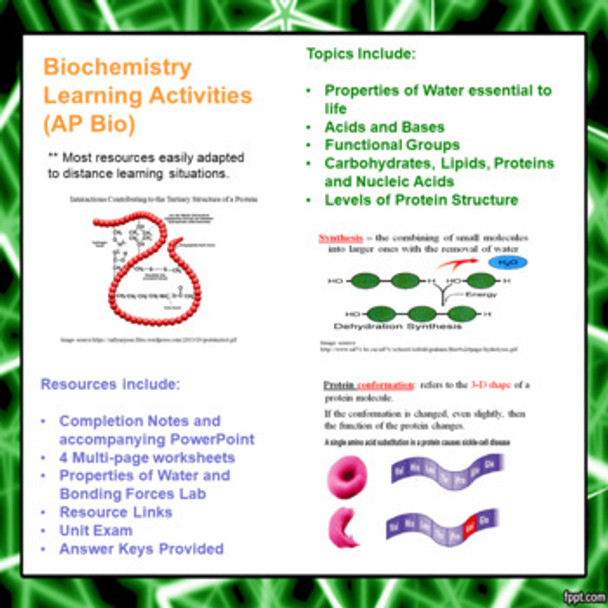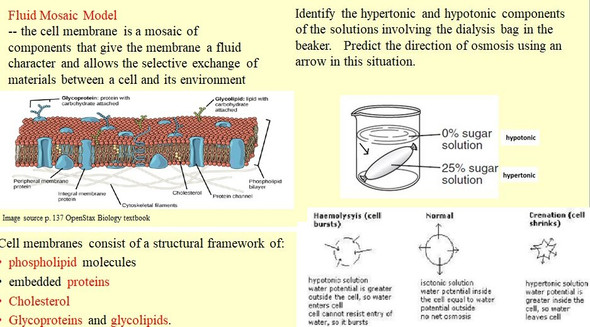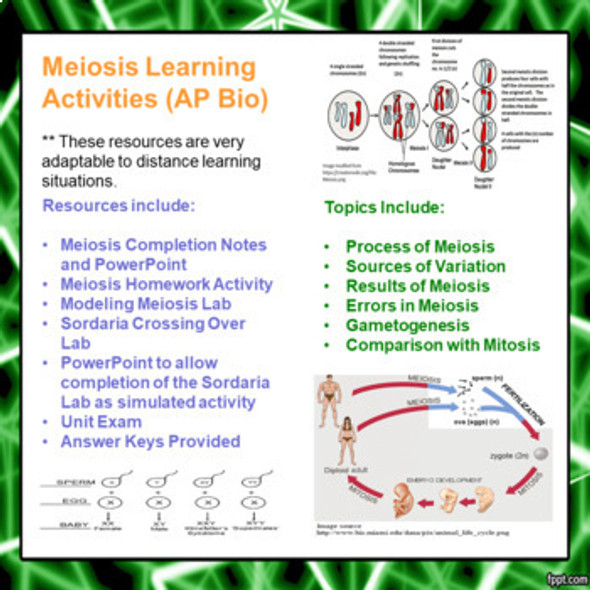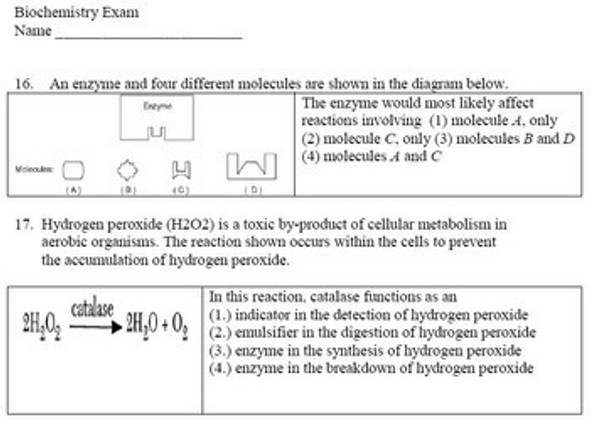Biochemistry Learning Activities for AP Biology (Distance Learning)
- Bulk Pricing:
- Buy in bulk and save
- Contributor:
- Monday's Rescue
- Grade Level:
- 9-12
- Product Type:
- Learning Package (Notes, PowerPoint, Lab, Homework)
- File Type:
- doc, pdf, ppt
- Pages:
- 78
- Answer Key:
- Yes
Description
This zip file contains many different activities (64 pages of student handouts and 1 PowerPoint with a total of 143 slides) which can be used to compose a unit for AP Biology or advanced Biology students involving the Properties of Water Essential to Life and Biochemistry. Topics in this unit include properties of water important to life, properties of carbon, key functional groups and monomers, carbohydrates (monosaccharides, dissacharides, and polysaccharides), lipids (neutral fats, phospholipids, oils, waxes, steroids), proteins, synthesis and hydrolysis reactions, levels of protein structure, denaturization and many other topics. The learning objectives have been updated to reflect the 2019-2020 curriculum redesign.
This lesson packet contains a listing of the learning goals, common core learning standards, NGSS learning standards and the AP Biology performance indicators addressed in these materials. These are included in the packet and at the end of the description of this lesson. The learning guides/assignments contain links to online resources to support student learning.
Most documents are included in both word doc or docx as well as pdf format to allow editing for specific teacher needs. These learning materials are well suited for a distance learning situation.
Answer keys are included for all items except for the three lab activities (as the answers and data obtained by students can exhibit a good deal of variation).
The specific contents of the learning package includes the following items (the page count for these items are actual student handouts as answer key page counts are not included):
- Biochemistry Learning Standards and Objectives (3 pages) in docx and pdf
- Biochemistry PowerPoint (135 slides)
- Biochemistry Completion (cloze) notes to accompany the PowerPoint (19 pages) in docx and pdf
- Properties of Water and Carbon Chemistry Quiz with key (5 pages) (includes 30 questions and 1 short answer question) in docx and pdf
- Biochemistry Exam (8 pages) (50 modified true-false, multiple choice and completion questions) in doc and pdf format
- Properties of Water Essential to Life Learning Guide/Assignment with key in docx and pdf format (4 pages)
- Biochemistry Learning Guide/Worksheet # 1 (Carbohydrates) with key in docx and pdf format (3 pages) (15 questions)
- Biochemistry Learning Guide/Worksheet # 2 (Lipids) with key in docx and pdf format (3 pages) (12 questions)
- Biochemistry Learning Guide/Worksheet # 3 (Proteins) with key in docx and pdf format (5 pages) (18 questions)
- Introduction to the Properties of Water and Bonding Forces Lab (3 pages) in docx and pdf
- Learning Links Including Lab Suggestions (1 page) in docx and pdf
Properties of Water and Introduction to Biochemistry Objectives ETS
Enduring Understandings
SYI-1 Living systems are organized in a hierarchy of structural levels that interact.
ENE-1 The highly complex organization of living systems requires constant input of energy and the exchange of macromolecules.
Learning Oblectives
SYI-1.A Explain how the properties of water that result from its polarity and hydrogen bonding affect its biological function.
SYI-1.B Describe the properties of the monomers and the type of bonds that connect the monomers in biological macromolecules.
SYI-1.C Explain how a change in the subunits of a polymer may lead to changes in structure or function of the macromolecule.
ENE-1.A Describe the composition of macromolecules required by living organisms.
NGSS Standard
HS-LS1-6. Construct and revise an explanation based on evidence for how carbon, hydrogen,and oxygen from sugar molecules may combine with other elements to form amino acids and/or other large carbon-based molecules.
Common Core State Standards Connections:
ELA/Literacy
RST.11-12.1 Cite specific textual evidence to support analysis of science and technical texts,attending to important distinctions the author makes and to any gaps or inconsistencies in the account.
WHST.9-12.2 Write informative/explanatory texts, including the narration of historical events, scientific procedures/ experiments, or technical processes.
WHST.9-12.5 Develop and strengthen writing as needed by planning, revising, editing, rewriting, or trying a new approach, focusing on addressing what is most significant for a specific purpose and audience.
WHST.9-12.9 Draw evidence from informational texts to support analysis, reflection, and research.
Mathematics
MP.4 Model with mathematics.
HSF-IF.C.7 Graph functions expressed symbolically and show key features of the graph, by hand in simple cases and using technology for more complicated cases.
Student Learning Goals (local)
Properties of Water Essential to Life
Upon completion of this unit the student will be able to:
1. describe the structure and geometry of a water molecule, and explain what properties emerge as a result of this structure.
2. explain the relationship between the polar nature of water and its ability to form hydrogen bonds.
3. list seven characteristics of water that are emergent properties resulting from hydrogen bonding and polar covalent bonding and explain how these properties relate to these concepts.
4. define the terms solute and solvent.
5. explain how the polarity of the water molecule makes it a versatile solvent.
6. distinguish between hydrophilic and hydrophobic substances.
Carbon Chemistry, Molecular Diversity, and Material Cycling
Upon the completion of this unit the student will be able to:
1. explain how carbons electron configuration influences the numbers and kinds of bonds carbon will form.
2. describe how carbon skeletons may vary, and explain how this variation contributes to the diversity and complexity of organic molecules.
3. define the term isomer and recognize its significance to the properties of compounds.
4. recognize the major functional groups and describe the chemical properties of organic molecules in which they occur.
5. explain how organisms exchange carbon, nitrogen, and phosphorus with the environment to grow, reproduce and maintain organization.
Introduction to Biochemistry
Upon the completion of this unit the student will be able to:
1. explain how carbohydrates can be recognized by their molecular formulae.
2. recognize the structural formula of glucose.
3. recognize the formulae and explain the difference between monosaccharides, disaccharides, and polysaccharides.
4. explain how disaccharides and polysaccharides can be synthesized from monosaccharides.
5. list some examples and uses for monosaccharides, disaccharides, and polysaccharides.
6. define and explain the difference between a hydrolysis reaction and a dehydration synthesis reaction.
7. describe the structure and function of the following classes of lipids; neutral lipids, phospholipids,and steroids.
8. describe the basic structure of proteins and recognize that these are formed from amino acid subunits.
9. recognize that twenty different kinds of amino acids exist and that these amino acids are different because they have different side chains or groups.
10. describe the basic structure of an amino acid.
11. list at least five different kinds of proteins and describe their functions.
12. distinguish between the following levels of protein structure; primary, secondary, tertiary, and quaternary.
13. explain why conformation changes may alter protein function.
Terms of Use
Purchase of the product is for classroom use by the purchaser only. It is a violation for individuals, schools, and districts to redistribute, sell, or post this item on the Internet or to other individuals.
This work is licensed under a Creative Commons Attribution-NonCommercial-ShareAlike 4.0 International License.
This learning package bundle is part of the AP Biology Complete Course. The complete course contains 22 learning package bundles in addition to this one. Save nearly 60% over the cost of buying 23 individual unit learning bundles with your purchase of the complete course.














